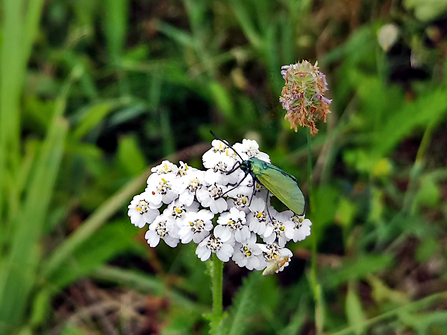The bright-green Forester moth (Adscita statices) was last seen in Hertfordshire in 1976 on the Trust’s nature reserve near Aldbury Nowers, near Tring. This new siting of the moth is on land in Maple Cross which is under threat from development. Herts and Middlesex Wildlife Trust are calling for the site to be protected from development to safeguard the species.
Rare moth at risk of extinction by planned development
Forester moth at Maple Cross (c) Martin Parr

Forester moth at Maple Cross (c) Martin Parr
The Forester moth was identified as a species of concern and presumed extinct in the Hertfordshire State of Nature report, published by the Trust in 2020. It is also listed as a ‘species of principle importance’ in the Natural Environment and Rural Communities Act 2006. Forester moths feed on specific wildflowers and have suffered from habitat loss in recent decades.
The proposed development at Maple Cross for two warehouses is highly contentious and has received objections from hundreds of local residents as well as Herts and Middlesex Wildlife Trust, The Colne Valley Regional Park Authority and The Maple Lodge Conservation Society.

Maple Cross development site (c) Martin Parr
Matt Dodds, Planning and Biodiversity Officer at Herts and Middlesex Wildlife Trust, said “the discovery of this incredibly rare moth carries with it the legal obligation for the Local Planning Authority to ensure that its population is not negatively affected. They must ensure that the development is compatible with the survival of the species or be in breach of their legal duty”.
If the development goes ahead as proposed it will cause the extinction of this incredibly rare species
The moth at Maple Cross was spotted by local wildlife enthusiast Martin Parr.
Martin said “As I walked over the site, it was clear to see how important it is for insects. There were butterflies, damsel flies and dragon flies everywhere - it was literally buzzing. Then I spotted the Forester, I was amazed. The last time I had seen one was in another part of the country back in 1992! It’s such a beautiful little moth and It certainly made my day. It is unbelievable that sites like this can be earmarked for development without even checking what wildlife they have. There is no excuse for that now, we know these are there and they must be protected."

Forester moth (c) Margaret Holland
The Forester takes its name from its iridescent green wings which are reminiscent of the green clothes historically worn by forest workers. The moths rely on specific wildflowers to lay their eggs and feed their caterpillars. Populations of the moth have been declining in recent years and the moth has been identified by Natural England as a focus species for the Back From The Brink project aimed at stopping the extinctions of critically endangered species in the UK
Colin Plant, County Moth Recorder for Hertfordshire, said “This nationally-rare moth has declined and contracted its range in Britain in the last twenty-five or so years and has become a species of conservation concern. It is now absent from much of the south-east region (including the Greater London area. Remaining populations are in Wales, North Norfolk and parts of north-east England. The caterpillar foodplant is present at Maple Cross and it is almost certain that this moth has established residency here. On this basis, the site can be regarded as having a Regional level of ecological interest in planning terms.”
In Hertfordshire, one-fifth of the wildlife assessed in Hertfordshire’s State of Nature Report, published by the Trust in 2020, is currently either locally extinct or threatened with extinction. Habitat loss and fragmentation have sent populations plummeting. The report concludes that at least 30% of land must be protected for wildlife in order to combat the ecological and climate crisis.
Local residents have until 20th August to comment on the planning application. Full details of the planning application can be found by searching 21/0573/FUL on Three Rivers District Council website.
